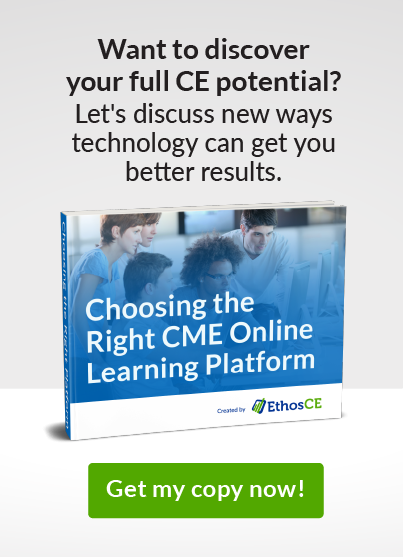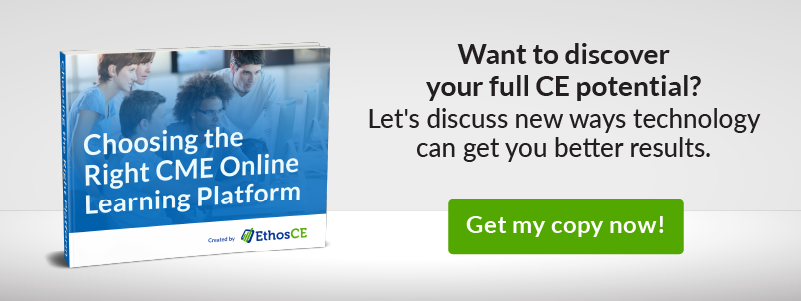3 Tips for Choosing CME Online Course Platforms
Decision fatigue is a real thing when it comes to choosing CME online course platforms. Some of them do different things for very different reasons, and you can burn yourself out quickly.
Online courses for professional development can indelibly impact the lives of both your staff and your patients. Choosing the right platform is vital to your success, so here are quick tips to make sure you select a platform that works for you.
1. Don’t start with the platform
It may seem counterintuitive, but a flashy list of features can distract you from what you really need in a platform. Before you make any big decisions, stop and think about the following.
Get clear about your CME goals
Your CME goals should drive your platform choices, not the other way around. Do you want learners to perform complex new procedures that require video training in conjunction with hands-on hours? You need a platform with rich multimedia capabilities and excellent learner self-service for recording those hours.
If you need learners to engage virtually with other learners in the field, the platform should have robust messaging and features designed to work with the discussion rather than against it.
If your course requires frequent recertifications or steps, you need something with reliable and most importantly, customizable follow-up reminders.
Once you’re clear on your goals, you can look past flashy features to the true essence of the platform. Know the features that you must have, as well as the deal-breakers, and evaluate the platform based on those. Clearer goals equal clearer decisions.
Consider your current and future audience
The platform must be accessible to current learners, as well as the types of learners you plan to have in the future. If you’re attracting talent in the medical field today but know that you’ll be restructuring your administration within the next five years, your course platform should be able to handle the pivot. Make sure that you won’t have to retrain learners in a few years and that the course structure or backend won’t be lost if you experience turnover in one department. This not only keeps your course evergreen but also ensures that the next person to take the reins has a chance of success.
Think of future courses
Medicine isn’t static. With new technologies, including artificial intelligence and big data, it’s changing even faster. Ensure that your course platform can keep up with both sweeping and minor changes so your courses remain on the cutting edge. You must be able to update and alter your course.
Think about the courses you’re offering now and how those might evolve in the coming years. If your current structure doesn’t lend itself to the evolution of the medical practice or is difficult to update, seek out a platform that can change with your field.
2. Be honest about what a platform can do
Platforms are not magic bullets. No platform will make all your learners finish the requirements or stay engaged as if there were no other outside pressures on their time and mental reserves.
A platform can only facilitate what you want to happen. The biggest obstacles to online course hosting can happen within three areas:
- Course features: Automation, self-service, ecommerce, etc. are all facilitators. What do your learners need out of the platform to have the best chance of success? Look to those features to help remove common obstacles.
- Back-office support: Bottlenecks can happen with recordkeeping and certificates. If the administration is frustrated with troubleshooting, record requests, and missing information, you’ll lose support for the entire course. Find tech tools that work for you instead.
- Customization: As information changes, you’ll need to update easily and quickly. Your platform should move at the speed of medical innovation.
3. Focus on content
Online course platforms only enhance dynamic, learner-centered content, which should always be front and center. Customization tools will let you build courses that fit the short- and long-term goals of your institution. You need the freedom to create courses that reflect your expertise and encourage the career trajectories of your learners.
Accreditation (from ACCME, for example) is essential for developing your CME. Online course platforms should integrate seamlessly with the certifications you need. A significant part of the appeal of online courses is the certification itself. Make it easy for your learners to earn and print their certificates.
Follow-ups and automation are the final pieces to ensure that your learners not only enroll but continue to work through the courses and provide any final assignments or information. These streamline recordkeeping and support administration.
The art of online course platforms
Your content should always be the highlight. A platform allows you to build your content needs effectively and facilitate online learning, both on the front end and in follow-ups. Allow the needs of your facility to determine what platform you choose, rather than the other way around.
To learn how EthosCE can enhance the continuing education of your medical professionals, request a free 1-on-1 demo with one of our specialists today!
 We're now part of the Cadmium product suite! Learn more
We're now part of the Cadmium product suite! Learn more 


